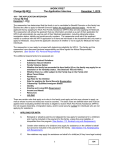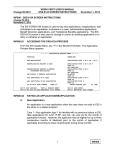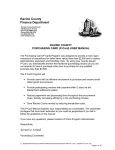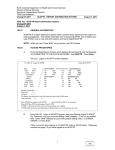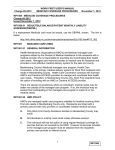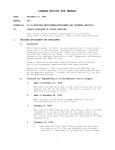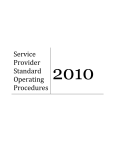Download WF 130
Transcript
Change #2-2011 WORK FIRST Application Processing March 1, 2011 130 – APPLICATION PROCESSING Change #2 2011 March 1, 2011 I. BACKGROUND After eligibility factors have been verified, approve or deny the application according to the procedures in this section. The applicant must be provided a written notice explaining the decision made on the application and the right to a hearing if the applicant disagrees with the decision. If more information is needed from the applicant, see the instructions in Section 104 on requesting information using form DSS-8146A (Notice of Information Needed to Determine Your Eligibility for Work First Family Assistance). II. ADMINISTRATIVE ACTIONS The following administrative actions do not require the signature of the applicant on the DSS8124. Ensure the DSS-8124 is coded correctly so that these actions are not counted in your county's processing thresholds. Refer to the Work First User manual for the appropriate codes. • • • • • • • III. Authorizing ongoing Medicaid for a Work First application approved as an open/shut. Transferring an individual from an open Work First case to a Medicaid case, including establishing a new Medicaid case for the individual. Denying an application taken in error. This includes actions to correct an incorrect date of application or incorrect application type. Posting earlier Medicaid eligibility to a terminated or an ongoing case when a DSS-8124 is required. Reopening cases due to a state or local appeal decision. Reopening cases terminated in error. Keying a reapplication because the original decision to deny was incorrect due to an erroneous eligibility decision. TIME STANDARDS The time standard for completing and processing an application is 45 calendar days. The 45-day time standard begins with the day after the date the application is signed. If the 45th calendar day falls on a non-workday, complete the application on the next workday following the 45th calendar day. To ensure the timely processing of applications use the DHREJA Adjusted Application Management Report which is available in XPTR under the name DHREJ ADJ APP Report Card. The exceptions to the 45-day time standard are: • • Applications reopened due to a local or state appeal reversal. Applications pending citizenship and/or identity verification. These exceptions will be discussed later. A. Approvals Processing time ends the date the initial and retroactive checks are mailed for Child Only cases (Payment Type 1). Processing time ends the date the approval notice is mailed or 1 130 WORK FIRST Application Processing Change #2-2011 March 1, 2011 given to the applicant for pay type S applications. For approvals of Work First Benefits (Payment Type 2) applications, the processing time ends the date the approval notice is mailed or given to the applicant. When a manual notice is given, override the automated notice and enter the date the manual notice is mailed or given to the applicant in the Disposition Date field on the DSS-8125. Please see the Work First User Manual, Section 1100.04 for exceptions to this rule. For applications that are approved effective with a future month (within the 45-day time frame), the processing time ends the date the approval notice is mailed or given to the applicant. The approval notice must inform the applicant the months for which he/she is ineligible and the reason. B. Denials For denials, the processing time ends the date the DSS-8109, Your Application for Benefits Is Being Denied or Withdrawn, is mailed or given to the applicant. EIS will automatically issue a denial notice to be sent the next workday, unless overridden. When a manual notice is given, override the automated notice and enter the date the manual notice is mailed or given to the applicant in the Disposition Date field on the DSS-8124. Example: A DSS-8124 is keyed on Friday, the 45th day to deny an application. The notice is automatically issued on the next workday, Monday, the 48th day. For the purpose of computing the time standards, this application was completed in 48 days and is overdue. However, if the caseworker had keyed the DSS-8124 on Friday, overrode the automated notice and mailed or given a manual notice, the application processing time is calculated as 45 days and meets the time standard. C. Withdrawals For withdrawals, the processing time ends the date the DSS-8109, is mailed or given to the applicant. Enter this date in the Date Dispositioned field on the DSS-8124. The caseworker must override the automated notice, DSS-8109A, when a withdrawal is required. D. Applications Pending For Citizenship/Identity Documentation See Section Manual Section111 Citizenship/Immigrant Rules for instructions on citizenship and identity documentation. The time standards for applications and reapplications pending proof of citizenship and identity vary. This section clarifies the time standard when all eligibility requirements are met except citizenship and identity. The preferred method of citizenship/identity verification for applicants stating they are a US citizen is a SSA Citizenship/Identity data match. The SSA data match is available through EIS when the DSS-8124 is keyed. The SSA data match is completed only for individuals who state they are US citizens and who have a social security number (ssn). A data match request can not be submitted for applicants without a social security number and individuals with a C/I code of 97 in EIS. Once the data match request is submitted a response is received from SSA which either verifies citizenship/identity or reports an exception. The match for citizenship is not completed until the exception is resolved. 1. The application may be approved if the data match verifies citizenship/identity for all family members and all other eligibility factors are met. The processing time standard is 45 days from the date of application. 2 130 WORK FIRST Application Processing Change #2-2011 2. March 1, 2011 Applications for which a data match is submitted and returned with a response that cannot be resolved within the 45-day time standard must be approved if all other eligibility factors are met. Although the case is approved, citizenship/identity has not been verified. The payee is given one 90 day period (lifetime) to provide acceptable proof of citizenship/identity for individuals with data match discrepancies. The 90 days are calculated from the date the first DSS-8146A is sent to the applicant requesting proof of citizenship/identity. If the applicant does not provide the information within 12 days, send a second DSS-8146A. The 90 day period remains the same. Do not give an additional 90 days from the date of the second 8146A. The caseworker must verify the citizenship within 90 days. If unable to verify, send a timely notice, DSS-8110, on the 91st day, or next workday following the 90th day to delete the individual from the case. Only one (lifetime) 90 day period is allowed per applicant while trying to resolve a discrepancy with SSA data. Citizenship proof must be provided before the inclusion of the deleted individual. See WF 111, Citizenship/Immigrant Rules. 3. A SSA match cannot be requested for applicants without a social security number and individuals with an existing citizenship code of 97 in EIS. Applications which include an individual with an existing citizenship/identity code 97 have received the 90 day (lifetime) period to provide acceptable proof of citizenship/identity. Determine citizenship/identity for these individuals using the documentation instructions in Manual Section 111, Citizenship/Immigrant Rules These applications or reapplications must pend up to six (6) months while efforts continue to verify citizenship/identity when all other eligibility factors are met. Pend the application by entering “CID” on the EIS date screen when: • • • The applicant is making a good faith effort to provide the documentation, or The county has not received verification from an agency request or inquiry, and All other eligibility requirements are met. While pending, days must be excluded from the application processing time. The worker must key the information to extend the processing timeframe on the date screen in EIS. The exclusion of days cannot begin any earlier than the 13th day after the citizenship/identity documentation was first requested. Calculate the six-month pending period by counting forward to the sixth calendar month following the month of application. The six month pending period ends on the same calendar day as the date of application. If the six month pending period ends on a non workday, dispose of the application the next workday. Process the application within 5 work days from the date when all information is received. If information to obtain the documentation is not received or the documentation request is returned as unable to confirm and all other efforts fail, deny the application for not providing necessary information to confirm citizenship and/or identity. 3 130 WORK FIRST Application Processing Change #2-2011 IV. March 1, 2011 REOPENING AN APPLICATION A. Re-openings Due to State or Local Appeal Decisions 1. 2. When an application is reopened as a result of a State or local appeal, request all information needed to process the application within five workdays of the date the Notice of Decision is final. Reopen the application based on the instructions in the appeal decision. a. For a State appeal, the Notice of Decision signed by the State hearing officer becomes final ten calendar days after the date it is signed. If the Notice of Decision is contested, it is not final until the date the Final Notice of Decision is signed. b. Notify the applicant verbally, when possible, and in writing on the DSS8146A of the information needed to complete the application. Within five workdays, key the DSS-8124 into EIS and request all information needed to process the application. See EIS instructions for authorizing benefits back to the original date of application. Date of reopen is the date the appeal decision is final. It is imperative that all EIS instructions regarding entry of data be followed. Inaccurate entry of data will negatively impact counties' processing statistics. In order for EIS to calculate correctly the total number of days the application pends, key a Date Screen. Show the original date of application on the date screen. 3. B. Complete the application within five workdays of receiving the last piece of information. Reopening Due to Incorrect Eligibility Decision The agency must reopen an application when it believes the original decision to deny was incorrect due to an erroneous eligibility decision. The applicant does not need to sign another DSS-8124. The original date of application must be honored. Key the application as soon as possible, and enter the current date as the date of application on the DSS-8124. In order for EIS to calculate correctly the total number of days the application pends, key a Date Screen. Show the original date of application on the date screen. Document the case record with the date and how the incorrect action was discovered. If all information required to process the application is available, take the appropriate action to approve or deny the application. If additional information is needed, use the DSS8146A to notify the applicant of the needed information, as well as their option to request help. It is advisable also to attempt to notify the applicant verbally. Allow at least ten calendar days following the date on the DSS-8146A for the applicant to provide the needed information or perform the required actions. V. APPLICANTS MOVING TO ANOTHER COUNTY If a family moves to a new county before the application for Work First Family Assistance is processed, determine eligibility for the month(s) the family resided in the prior county. If eligible, process an open/shut approval. Then, approve an administrative application to open the case in MAF-C, and reassign the MAF-C case to the new county according to Medicaid procedures. 4 130 Change #2-2011 VI. WORK FIRST Application Processing March 1, 2011 EFFECTIVE DATE OF PAYMENT/MEDICAID COVERAGE Authorize a payment beginning with the date of application if all eligibility requirements are met. Prorate the payment from the date of application. The number of eligible days includes the day of application. If all eligibility requirements are not met during the month of application, authorize a payment beginning the first month all eligibility requirements are met. Do not prorate any payment except for the month of application. Medicaid can be authorized the month the payment is effective, the month of application, or one, two, or three months prior to the month of application, provided there is medical need in the retroactive period. The applicant also must have met all conditions of Work First eligibility in the retroactive period. If the applicant does meet the condition in the retroactive months, authorize Medicaid during that month. If the applicant does not meet the eligibility for Work First during the retroactive period, evaluate eligibility for Medicaid in other aid categories for the retroactive period. VII. APPROVING AN APPLICATION Approve the application as soon as all required actions have been performed and all necessary verifications have been received. If all members of the family unit are eligible, key a DSS-8125 to authorize a payment from the date of application. Authorize Medicaid beginning with the first month of eligibility. Determine if there is a medical need for the prior three months for Medicaid. Instructions for keying a DSS-8125 are in of the Work First User Manual. A. Child Support Cooperation Status at Application At application, the caseworker must research ACTS cases via Online Verification (OLV) to evaluate the caretaker’s cooperation status regarding children included in the WFFA application. If the ACTS case has a cooperation status of “N”, the caseworker must instruct the caretaker to contact the Child Enforcement Office to establish cooperation. Use the DSS-8146A to document the deadline set for compliance, give at least twelve days but not to exceed the 45-day application processing timeframe. Verify cooperation status in ACTS before disposition of the application. At that time, the caseworker will evaluate whether the individual has cooperated since requested to do so. The worker may deny the application if the cooperation status is “N’ after the deadline established on the DSS-8146A. Evaluate the family members for Medicaid. B. Applications with An Open Sanction When there is an existing sanction in EIS without an end date, the information is displayed on the Sanction Tracking (SA) screen in EIS. For re-applications without an end date on the SA screen, evaluate whether the person is still out of compliance with the requirement that caused the sanction. End the sanction if the family’s situation has changed so that the requirement that caused the sanction is no longer applicable. If the requirement is still applicable, the caseworker must discuss the actions the applicant must complete in order to end the sanction. Use the DSS-8146a to document the deadline set for compliance. Give at least twelve days but do not exceed the 45-day application processing timeframe. At the deadline, the caseworker will evaluate whether the individual is still out of compliance with the requirement that caused the sanction. End the sanction if compliance occurs during the application-processing period. Deny 5 130 Change #2-2011 WORK FIRST Application Processing March 1, 2011 the application if the applicant fails to comply by the deadline set, without good cause. Evaluate family members for Medicaid. Example 1: A child only case was sanctioned for failing to ensure that a 17-year-old child attended school. The caretaker did not cooperate in efforts to require the child to attend school. The case transferred to Medicaid after three months of non-compliance. The family comes in to reapply. The 17 year old turned 18 years of age and is not attending school. Therefore, this individual can not be included in the family unit. All other children are attending school as required. End the existing sanction and approve the application without a sanction. Example 2: At reapplication, the worker verifies there is a child support sanction with no end date displayed on the SA screen in EIS. OLV/ACTS inquiry also displays a noncooperation status for a case for a child in the application. The worker explains to the applicant how to contact Child Support Enforcement and the requirement to cooperate, giving a deadline for cooperation. At the deadline, the worker looks at the noncooperation status in ACTS/OLV and verifies that the client is now cooperating. The sanction is ended, all other eligibility requirements are met, and the application is approved. VIII. ISSUANCE OF BENEFITS A. Applications Approved as Payment Type 1 Any time an application is approved by keying a DSS-8125 with a Payment Type 1 in EIS, the system will automatically issue the Work First payment beginning with the payment effective date keyed. The payments (except for future dates) are mailed two workdays after the DSS-8125 processes. B. Applications Approved as Payment Type 2 Any time an application is approved by keying a DSS-8125 with a Payment Type 2, EIS will post the Work First payment amounts to the Work First Benefits (WB) screen. Checks will not be automatically issued by EIS. The caseworker must manually issue the payments from the WB screen after an evaluation of compliance with provisions of the Mutual Responsibility Agreement(s). A check is produced (printed) the second work day after the caseworker changes the status on the WB screen from Hold (H) to Issue (I). The check is usually mailed the next work day after it is produced (printed). C. County-Issued Checks Any time an application is approved, the county has the option to issue a county check for the initial and any retroactive checks. It is recommended that county checks be issued when a case is approved due to an appeal or an administrative action because of the short time frame in which to act. The county may opt to issue a county check when the application is approved close to the end of the 45-day processing time period. If a county chooses to issue county checks in some situations, a tracking system must be established with county administration to ensure all county-issued checks are mailed timely. Ensure that the correct date is entered on the DMA-5022 for the date the countyissued check is mailed. Do not deduct an overpayment collection from a county-issued check. Begin the recoupment by a check reduction in the first non-retroactive check issued by the Division of Social Services. 6 130 Change #2-2011 WORK FIRST Application Processing March 1, 2011 The Error and Attention Report D. Data entry forms, such as the DSS-8125, that appear to contain errors will be listed on the Error and Attention Report, which is produced daily. The report is in NCXPTR and is entitled DHREJ E&A Rpt. It is important that corrections be made daily to cases that appear on this report to ensure timely and accurate benefits. IX. DENYING AN APPLICATION If the family does not provide necessary information or perform required actions by the deadline set and does not request additional time or assistance, the caseworker may deny the Work First application as early as the day after the deadline given on the DSS-8146A but no sooner than the 13th day). Evaluate each family member for Medicaid and process a Medicaid application, if appropriate, if the Work First application is denied. Deny assistance at any time during the application process when: • • The applicant refuses or fails to apply for unemployment benefits, when monetarily eligible, or refuses or fails to apply for other benefits, such as Social Security or veterans benefits, for which he/she may be eligible. The agency is unable to locate the applicant. Note: • • • Use this reason only when it is impossible to contact the applicant by letter or telephone or mail has been returned by the post office. Always make reasonable efforts to verify the applicant’s address, phone number, and other contact information. Check the address on the reception log or other possible sources, such as the telephone directory, internet, or postal official. An application may be denied if all efforts to contact the applicant have failed. Document in the case file the details of the attempts to locate the applicant. Do not deny an application because the applicant does not have a permanent address or is homeless. The applicant refuses or fails to apply for a required family unit member. The applicant refuses or fails to sign a Mutual Responsibility Agreement (either Core Requirements or Plan of Action, if required). Ineligibility has been verified, including situations in which the applicant’s statement results in ineligibility. For income and resources, if a range is given and the midpoint results in ineligibility but the low point does not, make at least one request of the applicant to provide information that is more precise. If all required actions have not been completed or all verifications have not been received by the 45th day, deny the application. Evaluate all family members for Medicaid and process a Medicaid application, if appropriate. If an application is pending solely for citizenship and/or identity verification and that is the only piece of information needed to process the application, refer to lll.D above and WF 111, Citizenship and Immigrant Requirements. X. OPEN/SHUT DISPOSITIONS If at any time during the application process it is determined a family is ineligible for Work First Family Assistance, determine if the family was eligible for any portion of time covered by the application. If the family is eligible for a portion of the time, contact the family to discuss Benefit 7 130 Change #2-2011 WORK FIRST Application Processing March 1, 2011 Diversion as an alternative to an open/shut disposition. If Benefit Diversion is not appropriate, approve assistance for only the time the family was eligible. Example: Ms. Smith applied for WFFA on March 5. On April 3, she calls to report that her husband returned to the home on April 1. He is employed full time, and his wages make the family ineligible for April. Evaluate Ms. Smith's eligibility for March. If eligibility is established, complete an open/shut for March if she does not want to pursue Benefit Diversion. Evaluate the family for ongoing Medicaid, including continuous eligibility for the child. If at any time during the application process the family makes a request to withdraw the application, explore with the family the possibility of eligibility for a specified period of time as an open/shut or Benefit Diversion case. If the family wishes to be evaluated for eligibility for any period of time beginning with the date of application, do not process a withdrawal. If the family is eligible, approve as an open/shut or Benefit Diversion for only the specified period of time and evaluate family members for continuing Medicaid. Example: Ms. Jones applied for WFFA on June 3. On July 5 she calls and makes a request to withdraw the application, as she will be going to work soon. Evaluate for Benefit Diversion, and/or determine eligibility considering the new income and offer Ms. Jones benefits as an open/shut. XI. APPROVAL FOR FUTURE EFFECTIVE DATE If the family is ineligible for one or two months beginning with the date of application but is eligible by the 45th day, approve the application effective with the first month of eligibility. Use the Notice of Approval DSS-8108 to inform the family of the months for which they are ineligible and the reason. Always evaluate each family member for Medicaid eligibility. Example: On February 28, Ms. Johnson applies for WFFA. Her final wage will be received on March 20. The verified wages for February and March cause ineligibility for both months. She has no income in April. If all other factors of eligibility are met, approve the WFFA beginning April 1. Evaluate the family for Medicaid for February, March, and the retroactive period. XII. Withdrawals When an applicant decides after he has signed the application that he is not interested in Work First Family Assistance, complete the DSS-8109, Notice of Denial or Withdrawal. Give the applicant the notice, and retain a copy for the case record. If the withdrawal request is made by mail or message, attempt to contact the applicant by phone. Ensure that the applicant is provided with correct information so that they make an informed decision regarding withdrawing or proceeding with the application. If unable to speak directly with the applicant, send the DSS8109. When an applicant wishes to withdraw an application, encourage the client to consider Medicaid, Food and Nutrition Services, and other services that may benefit the family. XIII. APPLICATION FOR AN ADDITIONAL PERSON(S) This section applies only to Work First Family Assistance. Additional persons are never added to applications for Benefit Diversion or to ongoing Benefit Diversion cases. To add an additional person to an ongoing case, refer to instructions in Section 202, Changes in Situation. To add an additional person(s) to a pending Work First Family Assistance application, obtain all required information concerning the additional person(s). If the person is not a required family member, the applicant should be informed that they are not required to apply for the additional 8 130 Change #2-2011 WORK FIRST Application Processing March 1, 2011 person(s). If a required family member moves into the household, send a DSS-8146A to inform the applicant they must apply for that person within ten days. If the applicant does not apply for the required family member by the tenth calendar day from the date of the DSS-8146A, deny the original pending application. Evaluate each family member for Medicaid. Do not hold the existing application pending for completion of the application for the additional person(s). If appropriate, negotiate a new Mutual Responsibility Agreement (s). If the new person is an adult, he or she must also sign the MRA(s). The payee must sign the DSS-8124 to add an additional person. Use a DSS-8146A to request any additional actions or verifications required, and set a deadline of no less than ten days for the applicant to complete the actions or provide the verifications. If the additional person(s) meets eligibility requirements, and the first application has been approved, authorize an adjusted payment, if appropriate. The payment should be prorated based on the number of eligible days, including the date of application. If the first application was approved as an open/shut and the additional person(s) meets eligibility requirements, do an open/shut approval for the additional person(s). Eligibility for the additional person(s) ends on the same day the first application was terminated. Authorize an additional payment, if appropriate. If the first application was denied, deny the application for the additional person(s). Evaluate each family member for Medicaid. 9 130









